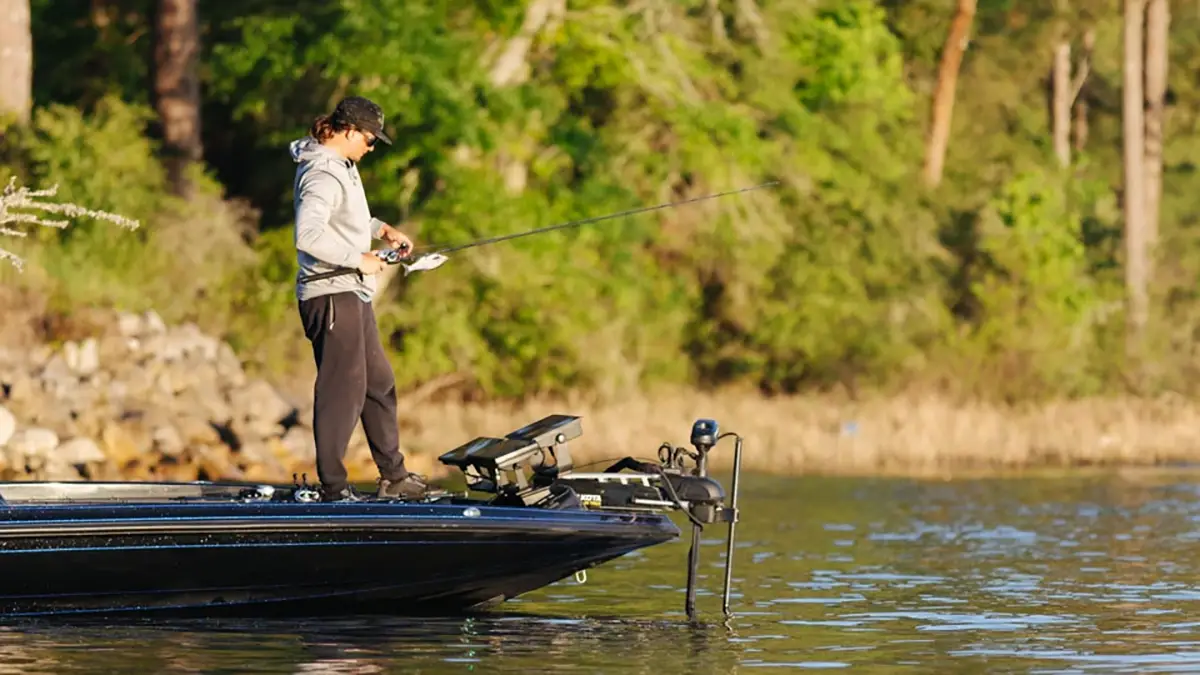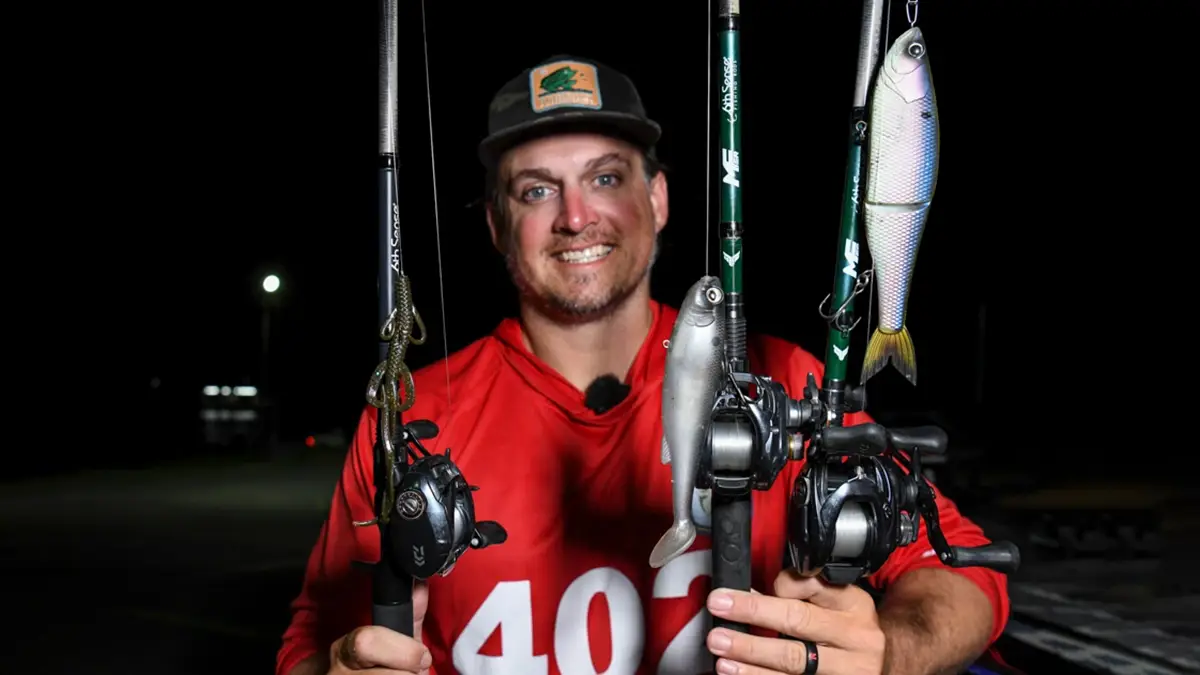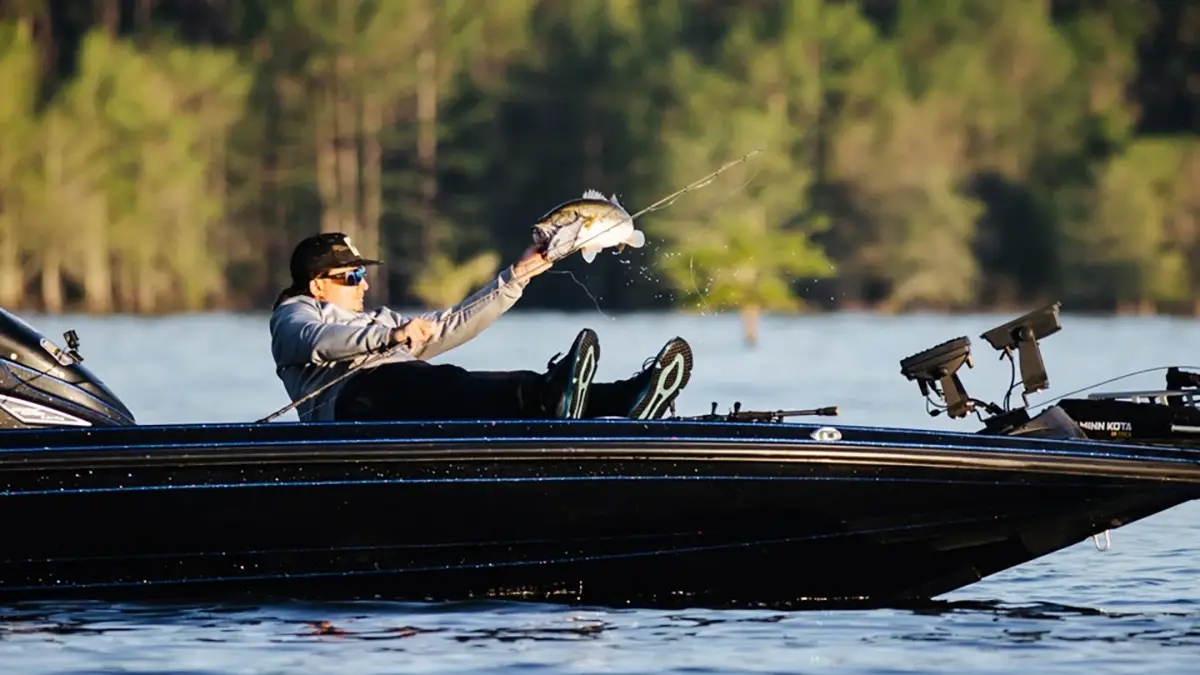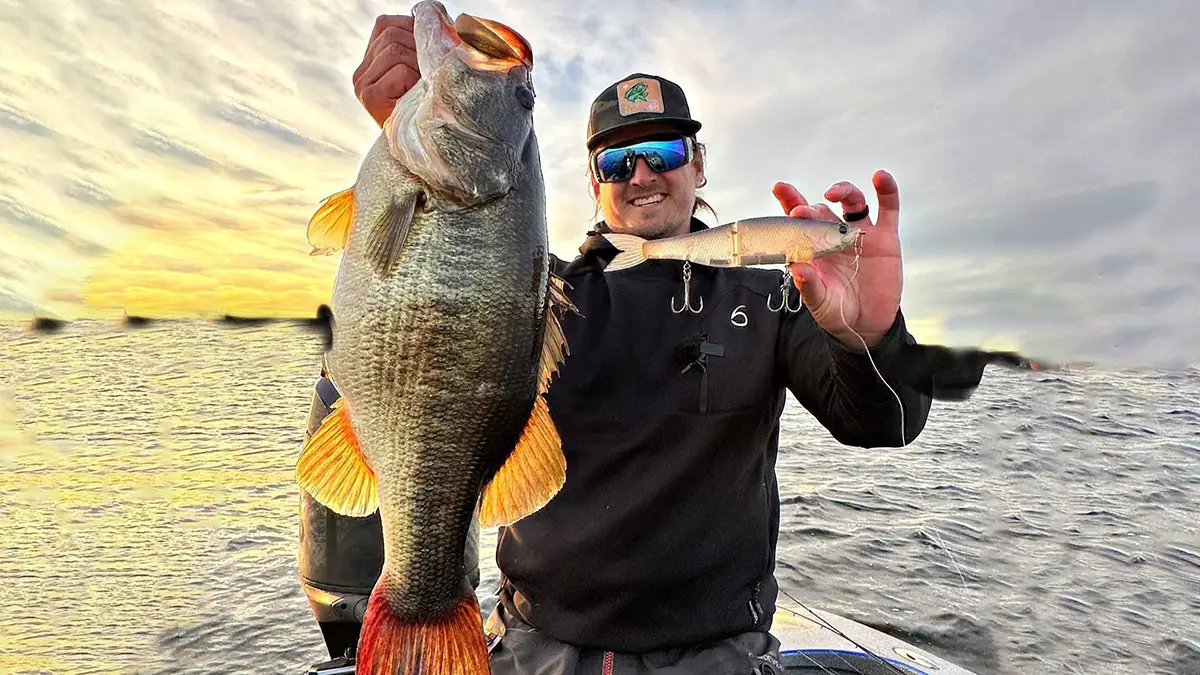Warning: Undefined variable $k in /home/nginx/domains/wired2fishcom.bigscoots-staging.com/public/wp-content/themes/understrap-child-0.6.0/functions.php on line 984
Warning: Undefined variable $k in /home/nginx/domains/wired2fishcom.bigscoots-staging.com/public/wp-content/themes/understrap-child-0.6.0/functions.php on line 987
Big swimbait fishing is creeping its way further and further into the mainstream bass fishing space. But it’s one thing to tie on an oversized swimbait and go lob it around during a fun fishing trip with a buddy. It’s a whole other deal to lock one in your hand when money is on the line. That’s exactly how Ben Milliken likes to roll, though. And it recently paid off big for him, to the tune of a 2024 Bassmaster Classic berth. Milliken shocked many tournament fishing with big swimbaits in April on Toledo Bend in route to winning his first St. Croix Bassmaster Open.
HOW BIG IS BIG WITH SWIMBAITS
We decided to sit down with Milliken to pick his brain on how an angler might go about fishing big baits in tournaments. So, we started with the obvious question: “What’s the biggest bait you’ve ever caught a bass on in a tournament?”
“I’ve got one that’s a 15- inch glide,” said Milliken. “I caught a couple on it last year in some weeknight tournaments.”
A bass as big as that bait would be a keeper on almost every fishery in the country. But that’s probably just a novelty bait right? Not something he’d throw during real competition?
“I did throw that 15-inch as well (at Toledo). The biggest one that I caught fish on was that Hinkle Shad. It’s about 10 inches, and it’s 6 ounces, I believe.”
For those that followed that Open, the Hinkle Shad is the big shad profile glide bait that was plastered all over Bassmaster.com. For baits this big, Milliken needs special equipment. He has roughly a dozen different rods for specific swimbaits and other big baits.
“With the Hinkle, I got one that’s an 8-footer, and it’s an extra heavy. But for anything bigger than like 6 or 7 ounces, then I’m going up to a 9-foot, 8-power rod. It’s a Dobyns 908. It’s my swimbait rod for anything that’s 8-plus ounces.”
Once upon a time, no rods over 8 feet were allowed in most larger tournaments. The rule was in place to keep anglers from using jigger poles, long cane poles with a short line used to dangle a bait in the water at a long distance from the boat.
“They didn’t want people out there poking around with 15 foot rods and stuff. The rule is 10 feet now. They changed it two years ago, I think. I definitely looked into it before the season started. Luckily they bumped that up.”

BIG SWIMBAITS IN TOURNAMENT SCENARIOS
“I always start off in practice with at least two or three different types of big baits on the front deck.”
Depending on the time of year, those swimbaits may include glide baits, soft plastic swimbaits, crank-down billed baits and big wake baits. Milliken has found that, even on fisheries where a 5-pounder is near the top end of the spectrum, the 2- to 3-pounders will still react to big baits.
“The tournament winning fish will follow those baits and actually eat them, better than some 5- or 6-inch swimbaits even. It’s just another tool in the box, kind of like an ultra-finesse type plastic. It’s the same type of mentality where you’re showing them something that’s just different than what everyone else is throwing.”
Milliken’s best piece of advise when it comes to big bait fishing, just get comfortable being uncomfortable. Intentionally try something outside of your comfort zone and stick with it long enough to give it a real chance.
“I think that a lot of people that fish the same type of waters or the same body of water every time they go fishing are definitely limiting themselves by only becoming proficient in one technique or one way of fishing. Where it seems like, in my head, it’s a lot more important to be versatile, especially with the Opens schedule.”
Competing with roughly 230 other boats this year in the Bassmaster St Croix Opens, Milliken knows he needs every advantage he can get. And the affinity for big baits that he’s built over many years offers him an advantage.
“Having the ability to pick up a larger than average bait than everyone else is throwing is an extremely effective way to be versatile and successful. That’s a big thing. Five days of practice at 230 boats beats down a fishery badly.”

WHERE TO START WITH BIG SWIMBAITS
Though Milliken has rods specifically designed for baits of all sizes and varieties, he has one all around combo that can handle the vast majority of the baits in his box.
“My favorite one, we have the 6th Sense Milliken Series Rod. It’s a 7-foot 9-inch extra heavy rod. It sounds like a huge rod, but it’s actually very light and nimble. It fishes soft and hard baits really well. And it can really handle baits up to 5 or 6 ounces.”
“I’ll match that with the Shimano Tranx, the 300 size. Or a Daiwa Tatula 300 size in like a 7:1 gear ratio, usually throwing 25-pound fluorocarbon. And that’s just a great all-around rod, reel and line setup for any bait in that 2- to 6-ounce range.”
When selecting a bait size to start out with, Milliken recommends something in the 6-inch range, whether it’s a glide bait or a soft body swimbait. These baits are easy to transition to from spinnerbaits, vibrating jigs and swim jigs, but they simply draw strikes from bass that have become conditioned to these other, more common lures.
Though there are dozens of rabbit holes to wander down and ten times as many nuisances to big bait fishing, during our conversation Milliken did point out four bait categories as general groupings that are worth looking at for an angler new to the big bait game: glide baits, soft swimbaits, crank-down baits and big wake baits.

Glide baits and crank downs
Presenting Milliken with the scenario of a laydown in 12 feet of water, he emphatically stated that he’d reach for a glide bait to start with, every time.
“One hundred percent, I’ll pick up a 9- or 10-inch glide bait. The first few casts, that’s what I’m going to be throwing. I’ll be making my first cast to the best part of that laydown with that big glide bait. That’s about as effective as you can get with a big swimbait.”
The glide bait is Milliken’s first choice almost anytime the cover permits, because of the baits drawing power. The aggressiveness of the fish day to day plays a big role in his bait selection, as do other determining factors like wind, water clarity, sunlight, etc. But if the bass are aggressive and the water has decent visibility, he knows the fish will traverse great distances to eat a glide.
“I think the bass can see a big 10 inch bait, if there’s 3 or 4 feet of visibility, from 20 to 25 feet away, whether they’re seeing it or feeling it with their lateral line.”
Even with such impressive drawing power, Milliken still tries to keep the guesswork out of it for the fish, bringing his bait within a couple feet of the cover. But if he really wants to get a bait down into cover, he swaps up his offering. In the previous example of a laydown, a crank-down bait works well.
“You want to hit the laydown the entire way through the cast and just burn it as quick as possible. So, it’s kind of like a throwing a big squarebill too.”
His crank-down bait of choice, the DRT (Division Rebel Tackle) Tiny Klash, has a removable bill in it. Take the bill out and you can do a lot with the bait out in open water. But with the bill in, the bait will dive down to about 8 feet and can be fished through heavy cover, especially wood. If you’re looking to fish through heavy vegetation, it’s time to pivot to a soft body bait.
Soft body baits and wake baits
“I worked with 6th Sense to create the Whale swimbait. It’s 4 and 1/2 inches. We’re coming out with a new one that’s a 6-inch bait that blows the Magdraft out of the water, but it’s not quite out yet.”
Though the Megabass Magdraft holds a special place in the hearts of many anglers, Milliken concedes the Magdraft is good shallow but struggles elsewhere.
“The Magdraft style baits are good for fishing shallow. But, I’m not a huge Magdraft fan because it doesn’t fish very well lower in the water column and it’s not a very weedless bait.”
Milliken believes that belly hook baits like the Magdraft are better for tournament fishing though, or rather they offer a better hookup ratio. Baits with a single top hook, rigged either on a jig head or with an internal weight, are harder for fish in the 2- to 4- pound range to eat well, especially spotted and smallmouth bass. And big swimbaits rigged weedless cause even more concern.
“In a tournament setting with a soft bait, it’s really difficult at times to get a big keel weighted swimbait hook through a 6- or 7- inch piece of plastic. That’s just a lot of plastic that can ball up on the hook if a fish doesn’t eat it perfectly or engulf it. So I’ll try to throw a line-through or a rigged treble-hook bait if possible.”
The weedless rigged soft swimbaits do still occupy a spot in Milliken’s tournament tackle box, however, when the treble-hook baits simply can’t compete because of the cover. This came into play at stop number three of the 2023 Bassmaster Opens Series at Buggs Island.
“We were fishing a lot of bushes and it was actually a really good way to get a better quality bite. The spinnerbait guys were kind of going through those areas and I could go behind them and get bites. But it’s something where you’ve really got to get a good cadence with it and let those fish eat it all the way, after you feel that first tick, before you set the hook on them.”
Not to be left out, there’s the big wake bait category. Baits like the MS Slammer and large wooden rats have been a favorite topwater offering of Milliken’s for quite some time.
“A 6- or 7-inch rat/MS Slammer style wake bait is a very, very high percentage bait to get fish to come up and eat a topwater when other guys are not quite getting the quality bites throwing a spook, a popper or a frog. Always straight braid on those.”

PUTTING IT ALL TOGETHER
Though Milliken admitted he could talk about big bait fishing all day, we had already broken off plenty for anglers to digest. So, at some point, the conversation had to end. This was as good of a stopping point as any.
To summarize a few of the running themes, you can get as technical and gear specific as you want, or you can keep it simple.
If you’re interested in getting into big bait fishing, Milliken recommends grabbing a reasonably sized glide bait (like the 6 1/2-inch 6th Sense Draw that he himself helped design), his 7-foot, 9-inch Milliken Series Rod (that he uses for most of his big bait fishing) and pair that rod up with a 300 size reel (spooled with 25-pound fluorocarbon).
That combo will work with the glide bait, as well as the crank down and the various soft-body baits. Shift to braided line if you want to try your luck with a big wake bait. And then just make up your mind that you’re going to stick with whatever big bait you tie on until you get bit. If you’ll do that, you will get bit, and your confidence will build. Then, you’ll be ready to go big in tournament settings with success just like Ben Milliken.












